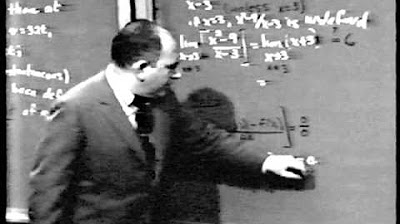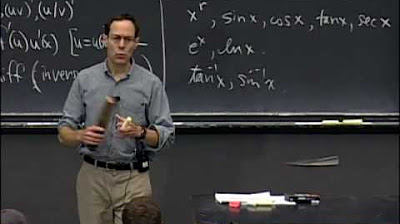Unit II: Lec 1 | MIT Calculus Revisited: Single Variable Calculus
TLDRThis MIT OpenCourseWare lecture introduces the concept of derivatives through a transition from a qualitative to a quantitative approach. The professor explains the basic definition of a derivative as a limit and demonstrates how to compute derivatives of simple functions like polynomials using the limit theorems. The lecture also covers the differentiation of sums and products of functions, highlighting the importance of rigorous proofs over intuition. Examples and potential pitfalls are provided to emphasize the need for careful mathematical reasoning.
Takeaways
- 📚 The script introduces the concept of derivatives in calculus, emphasizing the transition from a qualitative to a quantitative approach.
- 🔍 It explains the basic definition of a derivative as the limit of the average rate of change of a function as 'delta x' approaches 0.
- 📈 The process of finding derivatives using the limit definition is illustrated with the example of the function 'f(x) = x^3'.
- 📝 The Binomial Theorem is highlighted as a mathematical tool used to simplify the process of finding derivatives.
- 🆚 The script contrasts the derivative of a sum of functions with the product of their derivatives, demonstrating that they are not equivalent.
- 🤔 A cautionary note is provided about the common mistake of assuming that the limit of a function as 'delta x' approaches 0 is the function's value at that point.
- 📘 The Product Rule for derivatives is derived and explained, showing that it is the sum of the derivative of the first function times the second, and the first times the derivative of the second.
- 📙 The Quotient Rule is introduced, which is used to differentiate the quotient of two differentiable functions.
- 🔢 The script generalizes the power rule for derivatives to any integer exponent, including negative integers, using the Quotient Rule.
- 📚 The importance of understanding and applying the basic definition of derivatives is emphasized over memorizing individual formulas.
- 👍 The video concludes with a summary that reinforces the importance of using the basic definition to derive various derivative formulas for different functions.
Q & A
What is the main focus of the lecture in the provided script?
-The main focus of the lecture is to transition from a qualitative approach to a more quantitative approach to derivatives, introducing formulas for computing derivatives more efficiently than using the original definition.
What is the basic definition of the derivative of a function at a point?
-The basic definition of the derivative of a function 'f' at a point 'x1' is the limit as 'delta x' approaches 0 of (f(x1 + delta x) - f(x1)) / delta x, which represents the instantaneous rate of change of the function at that point.
How is the binomial theorem applied in the context of this lecture?
-The binomial theorem is applied to expand the function 'f(x1 + delta x)' when 'f(x)' is a power function, which simplifies the process of finding the derivative by canceling out terms and leaving a form that is easier to take the limit of as 'delta x' approaches 0.
What is the significance of the limit theorems in deriving derivatives?
-The limit theorems, such as the limit of a sum being the sum of the limits and the limit of a product being the product of the limits, are crucial in simplifying the expressions obtained from the basic definition of derivatives, making it possible to evaluate the limit as 'delta x' approaches 0.
What is the shortcut for differentiating a function of the form 'x to the n'?
-The shortcut for differentiating a function of the form 'x to the n', where 'n' is a positive whole number, is to bring down the exponent 'n' and replace it by 'n - 1', resulting in 'nx to the n - 1'.
What is the derivative of the sum of two differentiable functions f and g at a point x1?
-The derivative of the sum of two differentiable functions f and g at a point x1 is the sum of their derivatives at that point, i.e., (f + g)'(x1) = f'(x1) + g'(x1).
Why is it incorrect to assume that the derivative of a product is the product of the derivatives?
-It is incorrect because the derivative of a product involves additional terms that account for the interaction between the two functions being multiplied. The correct formula for the derivative of a product involves both the derivative of the first function times the second function and the first function times the derivative of the second function.
Can you provide an example where the limit of a function as x approaches a certain value does not equal the function's value at that point?
-An example is the function g(t) = (t^2 - 1) / (t - 1). The limit as t approaches 1 is 2, but g(1) does not exist because it results in a 0/0 indeterminate form.
What is the quotient rule for differentiating a quotient of two functions?
-The quotient rule states that if you have a quotient of two differentiable functions, say f(x)/g(x), its derivative is given by [g(x) * f'(x) - f(x) * g'(x)] / [g(x)]^2.
How does the script illustrate the importance of rigorous proofs over intuition in calculus?
-The script illustrates this by showing that while certain results, like the derivative of a sum being the sum of derivatives, may seem intuitive, others, such as the derivative of a product, are not and can lead to incorrect conclusions if not rigorously proven.
Outlines
📚 Introduction to Derivatives and Calculus
The narrator introduces the video as part of the MIT OpenCourseWare initiative, funded by Creative Commons to provide free educational resources. The professor begins by transitioning from a qualitative to a quantitative approach to derivatives, explaining the basic definition of a derivative as the limit of the average rate of change. The focus is on developing formulas for computing derivatives more efficiently, starting with simple functions like 'f(x) = x^3' and using the binomial theorem to illustrate the process.
🔍 Derivative of Power Functions and Binomial Theorem Application
The professor continues the lecture by generalizing the concept of derivatives for power functions 'f(x) = x^n', where 'n' is a positive whole number. The binomial theorem is applied to expand '(x1 + delta x)^n', and the process involves factoring out 'delta x' and taking the limit as 'delta x' approaches 0. The result is a formula for the derivative of any power function, 'f'(x) = nx^(n-1), which is then memorized as a shortcut for differentiating power functions.
📈 Derivatives of Sums and the Importance of Rigorous Proofs
The lecture moves on to discuss the derivative of a sum of two differentiable functions, 'f(x)' and 'g(x)', emphasizing the importance of rigorous proofs over intuition. The professor demonstrates that the derivative of the sum is the sum of the derivatives, 'h'(x) = 'f'(x) + 'g'(x), leading to 'h''(x) = 'f''(x) + 'g''(x). The section also highlights the potential pitfalls of assuming self-evident truths without proper proof, contrasting pure and applied mathematical approaches.
🚫 Counterexample to the Product Rule Misconception
The professor presents a counterexample to the misconception that the derivative of a product is the product of the derivatives, using the functions 'f(x) = x + 1' and 'g(x) = x - 1'. By demonstrating that differentiating first and then multiplying yields a different result than multiplying first and then differentiating, the importance of understanding and applying the correct rules is underscored.
📝 The Product Rule and Quotient Rule for Differentiation
The lecture introduces the product rule for differentiating the product of two functions, providing a step-by-step guide on how to apply the rule using the basic definition of a derivative. The quotient rule is also mentioned, with the professor leaving the proof to the viewers but providing the formula for differentiating a quotient of two functions. An example is given to illustrate the quotient rule, showing how to differentiate 'f(x) = x^(-n)' using the rule.
🔚 Summary of Derivative Definitions and the Power of Rigorous Methods
In the final paragraph, the professor summarizes the lecture by reiterating the basic definition of a derivative and the importance of deriving results from this definition rather than memorizing formulas. The power of rigorous mathematical methods is emphasized, and the professor encourages the use of these methods for a deeper understanding of calculus. The video concludes with a call to support MIT OpenCourseWare and a reminder of the importance of donations for educational accessibility.
Mindmap
Keywords
💡Derivative
💡Limit
💡Binomial Theorem
💡Differentiability
💡Product Rule
💡Quotient Rule
💡Continuity
💡Average Rate of Change
💡N-th Power
💡Sum of Derivatives
Highlights
Introduction to the concept of derivatives as the limit of an average rate of change.
Transition from a qualitative to a quantitative approach to derivatives.
Basic definition of the derivative using the limit process.
Application of the binomial theorem to compute derivatives.
Derivation of the derivative formula for functions of the form f(x) = x^n.
Generalization of the derivative formula for any positive integer exponent.
Differentiation of the sum of two differentiable functions, emphasizing the domain intersection.
Proof that the derivative of a sum is the sum of the derivatives.
Counterexample demonstrating that the derivative of a product is not the product of the derivatives.
Introduction and proof of the product rule for differentiation.
Clarification on the misuse of limit properties and the importance of proper limit understanding.
Differentiation of a quotient using the quotient rule.
Example of differentiating a function with a negative exponent using the quotient rule.
Emphasis on the importance of differentiability for the validity of certain limit properties.
Summary of the importance of the basic definition of derivatives and its manipulation for computational convenience.
Encouragement to derive results from the basic definition rather than memorizing them.
Final summary and sign-off, with a reminder of the upcoming lecture's focus on computational techniques.
Transcripts
Browse More Related Video

Unit I: Lec 5 | MIT Calculus Revisited: Single Variable Calculus

Lec 1 | MIT 18.01 Single Variable Calculus, Fall 2007

Lec 6 | MIT 18.01 Single Variable Calculus, Fall 2007

Unit I: Lec 4 | MIT Calculus Revisited: Single Variable Calculus

Lec 7: Exam 1 review | MIT 18.01 Single Variable Calculus, Fall 2007

Lecture 06: Derivatives the Esay Way Symbol Pushing
5.0 / 5 (0 votes)
Thanks for rating: